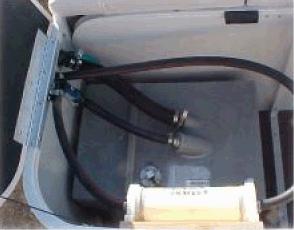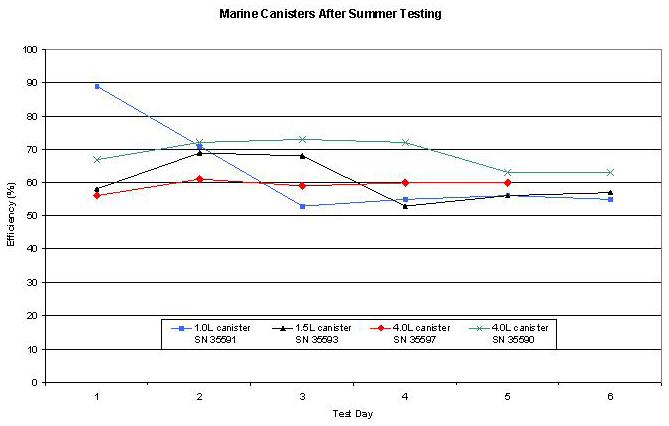NMMA Tests
Overview
- PERKO-Delphi Marine Canisters were added to 14 various size boats to determine if the addition of a carbon canister would create any issues.
- The canisters were on the boats for one summer testing season.
- The EPA requirement is for the canister to have an minimum efficiency of 50%. (capture 50% of the hydrocarbon going into the canister)
Test Boats
- 14 Boats In-Service (Sorted by Canister Size)
| Boat Builder | Boat Length (ft.) | Boat Type | Tank Capacity | Size of Canister |
|---|---|---|---|---|
| Four Winns | 17 | Open Bow | 24 Gallons | 1.0 Liter |
| Four Winns | 18 | Open Bow | 32 Gallons | 1.0 Liter |
| Crestliner | 17 | Open Boat | 24 Gallons | 1.0 Liter |
| Crestliner | 18 | Open Boat | 31 Gallons | 1.0 Liter |
| Crestliner | 23 | Pontoon | 25 Gallons | 1.0 Liter |
| Crestliner | 23 | Pontoon | 25 Gallons | 1.0 Liter |
| Four Winns | 19 | Open Bow | 50 Gallons | 1.5 Liter |
| Four Winns | 21 | Open Bow | 50 Gallons | 1.5 Liter |
| Four Winns | 27 | Cruiser | 85 Gallons | 2.5 Liter |
| Century | 26 | Sportfisherman | 150 Gallons | 4.0 Liter |
| Century | 26 | Off Shore | 150 Gallons | 4.0 Liter |
| Grady White | 23 | Off Shore | 150 Gallons | 4.0 Liter |
| Grady White | 30 | Off Shore | 2 x 150 Gallons† | 4.0 Liter |
| Century | 29 | Sportfisherman | 300 Gallons | 2 x 3.0 Liter (in series) |
Typical Installation of Canister for Testing


The canister was protected from fuel slosh and from water splash.
Note - This alone will not be a production solution. A 5% vapor space must be maintained in fuel tank to allow for thermal expansion of the fuel.
Canister Efficiency Testing
The mass of hydrocarbons that the test canister holds divided by the total amount of hydrocarbons sent to the test and slave canister times 100.
- Use nominal carbon BWC (e.g. 9.2 BWC - 9.3 BWC), nominal carbon fill, nominal canister housing.
- Stabilize the canister by loading to a 2 gram breakthrough with a 50/50 mixture of butane/nitrogen for a minimum of 10 cycles. The load rate shall be 15 grams/hour followed by a 100 bed volume purge at 22.7L/min.
- Weight test canister and a purged slave canister which is used to measure test canister breakthrough amount.
- Connect test canister vapor inlet tube to fuel tank or proper volume for canister size (1 liter of canister volume for every 25 gallon of fuel tank volume). Fuel tank should be 40% full of 9 RVP test fuel.
- Connect air inlet of test canister to a purged slave canister.
- Place fuel tank, test canister, and slave canister inside a variable temperature camber.
- Temperature cycle the chamber from 72-96-72°F per the EPA diurnal temperature profile.
- Measure the weight gain of the test canister and the slave canister after the chamber has been heating for 12 hours.
- Disconnect the slave canister from the test canister for the cool down portion of the diurnal. This allows the test canister to be passively purged by the fuel tank. Purge the slave canister for 300 bed volumes at 22.7 L/min. to prepare it for the next day. Re-weigh the slave canister after purge.
- Repeat steps 4 through 8 for a total of 5 days.
- Calculate test canister efficiency for the 5th day.
Testing Results

